August 16, 2010 – 09:30 am EDT
Last week we warned that things didn’t look good, that volume flows suggested resistance would not be broken, that the trend change had failed and that the likely hood of a good rally had diminished almost entirely. Sadly this all turned out to be true and now some major technical damage has been done.
****Was this kind of advance warning of value to you? If it was then please return the favor by inviting others to subscribe. The more readers we have the more services we can provide for you. Please send people to http://etfhq.com to subscribe – Thanks in advance for your support!
.
ETF % Change Comparison
.

Here you start to get an indication to the extent of the damage. SMH lead the declines with a 7.29% drop, followed by IWM down 6.25%. Notice how the more stable SPY and DIA have held together much better by nearly every measure. With the more economically sensitive ETFs leading the market lower we can see that the bears mean business.
Note – I have removed the ranking section due to the confusion it was causing.
Learn more – ETF % Change Comparison
.
![]()
.
A Look at the Charts
.
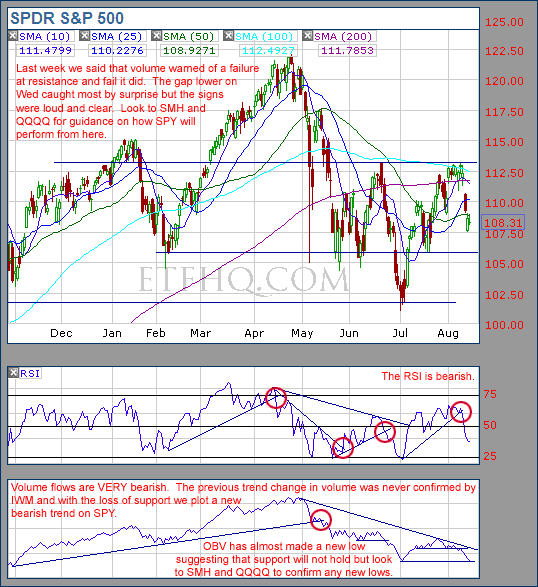
We warned of failure at resistance and fail it did. Now new lows look likely but SMH and QQQQ will lead the way as usual.
.
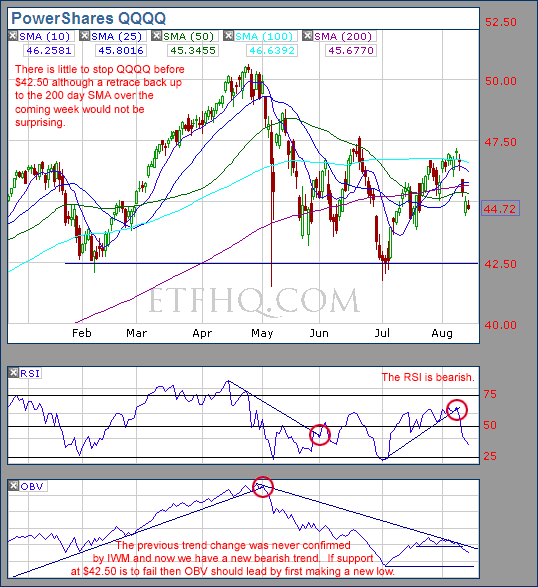
Volume on QQQQ is not nearly as bad as SPY which is positive. A test of the 200 day SMA resistance is a real possibility.
.
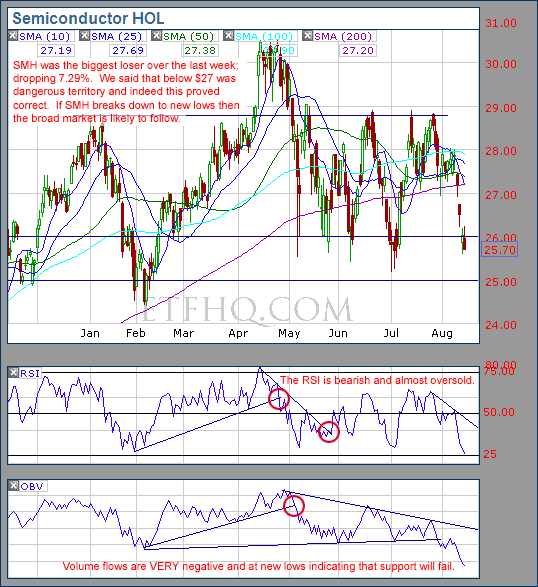
SMH is screaming new lows! If that happens then the broad market is likely to follow.
.
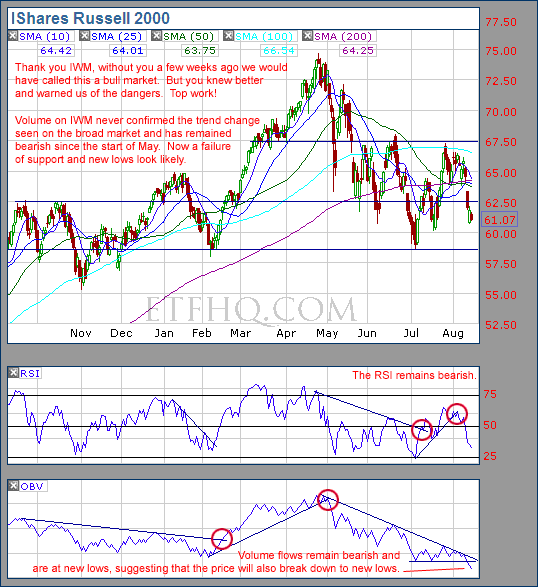
Yes is was worth the wait. IWM saved us from being faked into turning bullish and now warns of new lows to come.
.
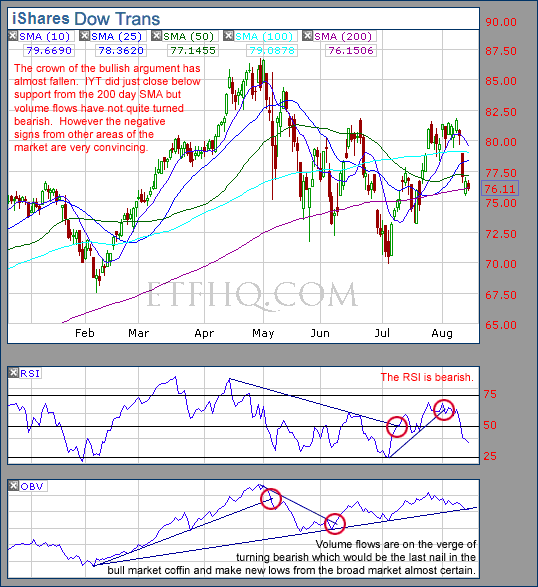
The strongest bullish argument has almost gone. A trend change from OBV = goodbye crab market, hello bear market!
.
![]()
.
OM3 Weekly Indicator
.

The bear alerts are not a surprise after such sharp declines and the strongest sell signal is coming from SMH; this is not a good sign.
Learn more – The OM3 Indicator
.
![]()
TransDow & NasDow
.

Unfortunately the 2% profit on the Transports has turned into a 3.84% loss but it could have been much worse. Now the Dow is dominant over both the Transports and the NASDAQ. Historically the market has been very unproductive under these conditions and has seen most of its major declines.
.
What the TransDow Readings tell us:
The TransDow measures dominance between the DJ Transportation Index (DJTI) and the Dow Jones Industrial Average (DJIA). In a strong market the more economically sensitive Transportation Index should be dominant over the DJIA.
Historically the DJTI has been dominant over the Dow 45% of the time. The annualized rate of return from the DJTI during this period was 18.47% with the biggest loss for one trade sitting at -13.27%. The annualized return from the DJIA during the periods it was dominant over the DJTI was just 4.06% and the biggest loss for one trade was -16.13%. A 4% stop-loss is applied to all trades adjusting positions only at the end of the week.
What the NasDow Readings tell us:
The NasDow measures dominance between the NASDAQ and the DJIA. Using the same theory behind the Trans Dow; in a strong market the more economically sensitive NASDAQ should be dominant over the DJIA.
Historically the NASDAQ has been dominant over the DJIA 44% of the time. Taking only the trades when the NASDAQ is above its 40 week moving average the annualized rate of return was 25.47% with the biggest loss for one trade sitting at –8.59%. The annualized rate on the DJIA during the periods it was dominant over the NASDAQ is just 8.88% and the biggest loss for one trade was –12.28%. A 8% stop-loss is applied to all trades adjusting positions only at the end of the week.
.
![]()
.
LTMF 80 & Liquid Q
.

Both LTMF 80 and Liquid Q remain in cash.
.
Historical Stats:
.

.
How The LTMF 80 Works
LTMF stands for Long Term Market Forecaster. It reads volume flows relative to price action and looks for out performance of volume measured on a percentage basis over the prior 12 months. During a sustained rally the readings will reach high levels (near 100%) making it imposable for the volume reading to always outperform price so any reading above 80% will maintain the buy signal. This system has outperformed the market over the last 10 years but performance has been damaged by some nasty losses. It only produces buy signals and only for QQQQ.
How Liquid Q Works
Liquid Q completely ignores price action and instead measures the relative flow of money between a selection of economically sensitive and comparatively stable ares of the market. It looks for times when the smart money is confident and and can be seen by through volume investing heavily is more risky areas due to an expectation of expansion. This system has outperformed the market over the last 10 years and remained in cash through most of the major declines. It only produces buy signals and only for QQQQ. We will provide more performance details on the web site for these systems soon.
.
![]()
.
Summary
Volume on SMH and IWM points to a failure of support and new lows to come while volume on QQQQ is not nearly as negative and IYT is on the verge of turning bearish. The vast majority of the evidence points towards an end of the crab market and a continuation of the bearish trend. However after such a sharp sell off I wouldn’t be surprised to see a mild bounce but any bounce will only delay the declines that are highly likely to be around the corner.
.
Any disputes, questions, queries, comments or theories are most welcome in the comments section below.
.
Cheers
Derry
And the Team @ ETF HQ
“Equipping you to win on Wall St so that you can reach your financial goals.”
.
P.S Like ETFHQ on Facebook – HERE
.
![]()
.
Quote of the Day:
“Start a business while you’re young. You’re able to sacrifice a lot more and put in the time necessary. It’s much harder and more time consuming that you ever would have thought.” – Rob Crespi founder of ‘Just Salad’